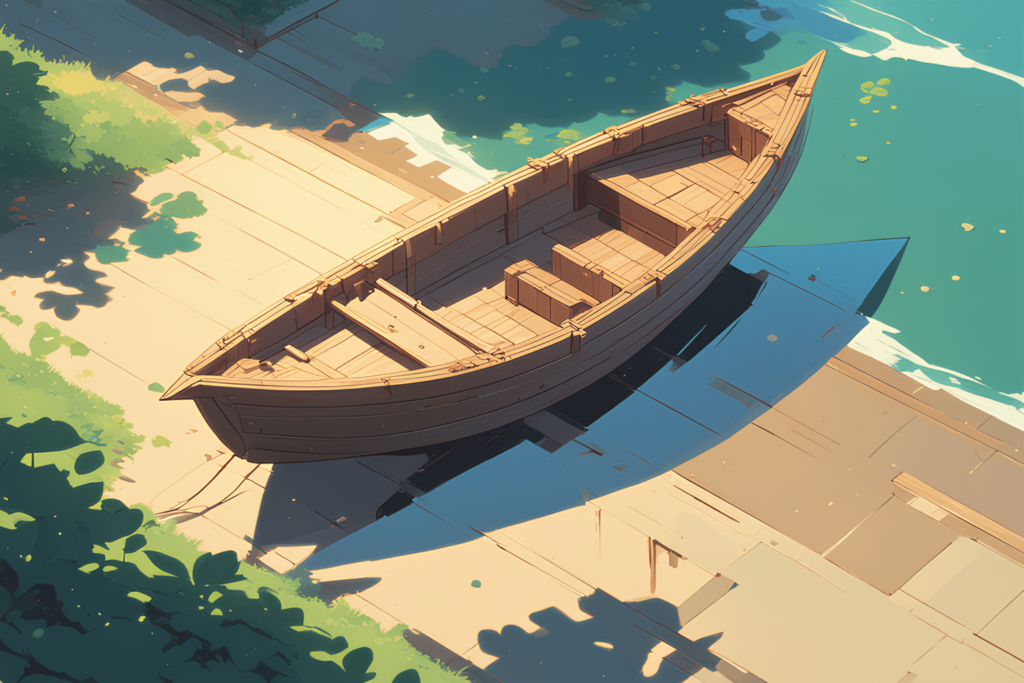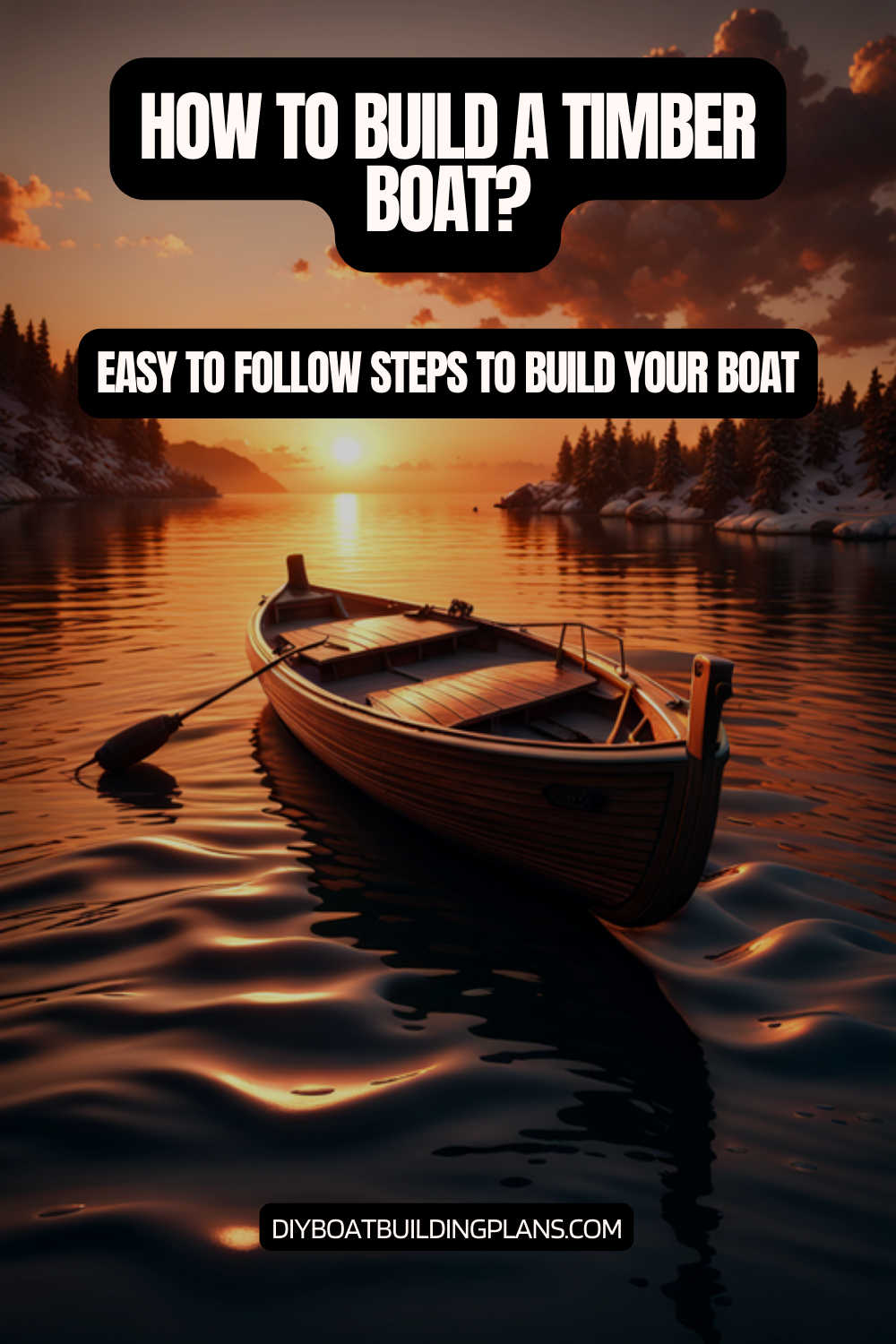Ever thought about turning raw timber into a boat? Or maybe you dream of making a wooden boat that shows off your skills and love for the sea?
Building wooden boats is more than a hobby. It’s an art that needs skill, creativity, and patience. By building your own boat at home, you can turn raw materials into a real boat.
Creating a timber boat takes hard work, careful planning, and a good grasp of woodworking. From picking the right wood to learning complex building methods, this challenge will push your skills. But it will also give you a huge sense of pride.
Key Takeaways – How To Build a Timber Boat
- Wooden boat construction demands meticulous planning and patience
- DIY boat projects require specialized tools and techniques
- Home boatbuilding is a rewarding and skill-intensive process
- Proper material selection is key for a durable boat
- Pay close attention to details for a successful boat project

Understanding the Basics of Timber Boat Building
Making a timber boat is a mix of woodworking and boat engineering. It needs picking the right materials and knowing how to design a boat. Builders must be precise and knowledgeable in their work.
Choosing the right timber is key for a strong and seaworthy boat. The wood’s quality affects the boat’s performance, how long it lasts, and its strength.
Importance of Choosing the Right Timber
Not all woods are good for boat building. The best timber must handle water well, not rot, and stay strong. Boat builders look at several important things:
- Water resistance
- Durability against marine environments
- Weight and strength characteristics
- Ability to bond with marine adhesives
Types of Timber Suitable for Boat Building
There are many timbers that work well for small boats. Here’s a list of the best ones:
| Timber Type | Characteristics | Best Used For |
|---|---|---|
| Marine Plywood | Water-resistant, lightweight | Hull planking, deck construction |
| White Oak | Dense, strong, naturally water-resistant | Structural frames, keel construction |
| Northern White Cedar | Lightweight, rot-resistant | Planking, interior components |
| Mahogany | Beautiful grain, excellent durability | Trim work, decorative elements |
“Choosing the right timber is the foundation of successful boat building.” – Traditional Boat Crafting Wisdom
Knowing about timber helps craftsmen make boats that are both reliable and beautiful. These boats can handle tough marine conditions well.
Essential Tools for Building a Timber Boat
Starting a timber boat project needs the right tools. These tools will help you go from beginner to pro in boat carpentry. The right tools make the job easier, more precise, and of higher quality.
Good boat builders know the importance of having the right tools. Your toolkit will have hand tools and power tools.
Essential Hand Tools for Boat Building
- Japanese Crosscut Saws (known for precision and durability)
- Sharp Chisels and Planes
- Accurate Measuring Tools
- Versatile Clamps
- Quality Screwdrivers
Power Tools for Enhanced Efficiency
- Cordless Drill with Multiple Bits
- Random Orbital Sander
- Jigsaw (essential for curved cuts)
- Belt Sander
| Tool Category | Key Features | Importance in Boat Carpentry |
|---|---|---|
| Hand Tools | Precision, Manual Control | Detailed Work, Craftsmanship |
| Power Tools | Speed, Efficiency | Large Surface Preparation |
“A well-equipped workshop is the foundation of exceptional boat carpentry techniques.” – Master Boat Builder
Choose tools that are high in quality and accuracy. Boatbuilders say to pick square tools for better precision. Keep your tools sharp and clean for the best results.
Always think about safety first. Wear safety goggles, dust masks, and gloves to stay safe while building your boat.
Designing Your Own Timber Boat
Building a timber boat starts with a creative idea and careful planning. You need to think about the framing methods and designs that fit your needs and skills.
Before starting to build, it’s important to understand key design points. The purpose of your boat will shape its design. This could be a sailing canoe, fishing boat, or a fun watercraft.
Essential Design Considerations
When designing your timber boat, keep these points in mind:
- Hull shape and how it performs
- The type of water it will be in (lakes, rivers, coastal)
- How many people it will hold and weight balance
- The strength and lasting power of the materials
Creating Your Boat Blueprint
Creating a detailed blueprint involves several steps:
- Begin with rough sketches of your boat idea
- Figure out the exact measurements and scale
- Make detailed drawings of the framing methods
- Build full-size cardboard models of key parts
“A well-designed boat begins with meticulous planning and attention to detail.” – Boat Design Expert
For more complex designs, think about using special boat design software. Or, get advice from seasoned boat builders. They can help with timber boat designs and framing methods.
Unlock the secrets to building your dream boat with MyBoatPlans! With detailed plans for over 518 boats and expert video tutorials, you’ll have everything you need to create your perfect vessel. Click here to begin your journey!”
Preparing Your Workspace
Starting a home boatbuilding project means setting up the right space. The area you choose can greatly affect your experience. A well-planned space ensures safety, efficiency, and fun during the build.
Creating a Safe and Functional Workspace
When setting up your boat building area, consider these critical factors:
- Ensure adequate lighting to see detailed work
- Provide good ventilation for working with epoxy and wood
- Maintain a stable temperature between 60-75°F
- Create at least 20 square feet of clear working space
Organizing Tools and Materials
Efficient organization is key to smooth DIY boat projects. Consider implementing a strategic tool and material management system:
| Area | Recommended Setup |
|---|---|
| Workbench | Sturdy, level surface with built-in vise |
| Tool Storage | Pegboard or wall-mounted tool rack |
| Material Storage | Dry, climate-controlled shelving |
“A well-organized workspace is the foundation of successful boat building.” – Professional Boat Craftsman
Safety should always be your top priority. Invest in proper protective gear like safety glasses, hearing protection, and dust masks. Keep a fire extinguisher nearby and ensure your workspace has good electrical safety with properly grounded outlets.
Remember, careful preparation of your workspace will set the stage for a successful home boatbuilding adventure.
Acquiring Materials for Your Build
Building a wooden boat starts with picking the right materials. The right materials are key to making your boat last and perform well on the water.
Selecting Quality Timber
The core of a wooden boat is its timber. When picking wood, keep these points in mind:
- Rot resistance: Opt for woods like cedar or cypress that resist rot
- Grain quality: Go for timber with straight grain and few knots
- Moisture content: Make sure the wood is dry to avoid warping
“In boat building, your materials are your foundation. Choose wisely, and your boat will thank you.” – Traditional Boatbuilder’s Wisdom
Essential Additional Materials
For a successful boat, you’ll need more than just timber:
- Marine-grade plywood for strength
- Epoxy resin to keep it dry
- Fiberglass cloth for extra strength
- Fasteners that won’t rust
Using marine-grade adhesives is also vital. Stainless steel or hot-dipped galvanized screws last the longest.
Sourcing and Cost Considerations
Quality is more important than quantity. While buying in bulk can save money, don’t sacrifice quality for savings. Look for trusted marine supply stores and timber merchants for your materials.
Building the Hull of Your Timber Boat
Making the hull is the core of building a timber boat. Knowing how to frame and plank your boat turns your woodworking into a real vessel. You’ll need precision and patience for this detailed work.
Building a strong hull needs careful planning and special skills. Bruce Roberts points out that only five percent of boat builders finish their projects. So, your dedication is key.
Essential Hull Framing Techniques
- Choose quality specialty woods like Western Red Cedar or Sitka Spruce
- Make a strong center rib as the boat’s backbone
- Build precise stem and transom parts
- Add chines and inwales for strength
Planking Your Boat Hull
The strip planking method uses thin wood strips, about 1/8 inch thick, up to 27 feet long. This method adds strength and flexibility to your boat’s hull.
Building a wooden boat is a hard project that needs some woodworking skills but is doable with hard work.
Professional Hull Construction Tips
- Use epoxy and screws for strong bonds
- Apply proper clamping methods
- Keep the frame symmetrical
- Coat the hull with 2 oz. fiberglass cloth in epoxy resin
Joining the boatbuilding community and getting tips from experts can boost your skills in building the hull.
Adding the Deck and Other Features
Building the deck is a key step in making your timber boat ready for the water. It’s not just for walking; it’s a vital part of your boat’s design and how it performs.
Building the deck needs careful attention to how the wood is joined. Plywood is often used because it’s strong and easy to find. Experts say to think about a few things when designing the deck:
- How well it drains water
- How slippery it is
- How strong it is
- How well it keeps out moisture
Selecting Deck Materials
When picking materials for the deck, look for woods that last long and can handle the sea. Cedar is a top pick for making decks that keep water out.
Download over 500 Boat Plans. Click on the link below.
-->Click Here<--
| Wood Type | Characteristics | Recommended Use |
|---|---|---|
| Cedar | Moisture resistant, stable | Primary deck material |
| Marine Plywood | Strong, lightweight | Deck framing |
Adding Storage and Seating
Make your boat more useful by adding smart storage and comfy seats. Think about built-in spots that fit with the deck’s look, giving you space without losing style.
A well-designed deck is not just about looks—it’s about creating a functional, safe, and enjoyable maritime experience.
Use boat joinery that makes sure the deck is tight and strong. Make sure the deck beams are the right size, like 5/8″ × 1½” to 3/4″ × 2″, for a solid boat.
Finishing Touches for Your Timber Boat
Finishing your DIY boat project needs careful attention to details. The final stages are key to protecting your work and making the boat last longer. Good finishing makes the boat look better and keeps the wood safe from the environment.
Sanding and Sealing the Wood
Getting a smooth finish starts with sanding. Use coarse-grit sandpaper first, then move to finer grits. This makes the surface ready for sealing and painting. Craftsmen used tools like the Multi Plane for precise finishing.
- Start with 80-grit sandpaper
- Move to 120-grit
- Finish with 220-grit for a smooth surface
- Remove all dust between sanding stages
Selecting the Perfect Protection
Choosing the right paint or stain is key for wooden boats. Marine-grade products protect against water and UV damage.
| Finish Type | Best Used For | Durability |
|---|---|---|
| Marine Varnish | Brightwork and exposed wood | High UV protection |
| Epoxy Sealer | Moisture barrier | Excellent water resistance |
| Marine Paint | Hull protection | Maximum exterior protection |
Pro Tip: Apply multiple thin coats for the best protection and smoothest finish.
DIY boat projects need patience in the finishing stage. Take your time with each coat, letting it dry fully before adding more. The Bird’s Beak technique adds elegance to your wooden boat.
Testing Your Timber Boat
After putting in a lot of work on your boat, it’s time to test it. This is the moment of truth. It makes sure your boat is ready for its first trip out.
Before you start, there are a few things to do. They help make sure your boat’s first trip goes well:
- Check if the boat’s structure is strong
- Make sure all seams are sealed tight
- Check how the boat balances
- Get all safety gear ready
Preparing for a Trial Run
When you first test your boat, pay close attention to every detail. Start by looking over the boat carefully. Look for any weak spots or safety issues.
“Careful preparation prevents poor performance” – Boatbuilding Wisdom
Safety Precautions Before Launch
When you test your boat, safety comes first. Make a safety kit with:
- Life jackets for everyone
- Emergency flares
- A first aid kit
- A way to call for help
- A waterproof flashlight
Pro tip: Test your boat in calm, shallow water first. This reduces risks and lets you make any needed changes. Be ready to fix small things after the first test. This is normal.
Maintenance Tips for Your Timber Boat
Keeping your wooden boat in top shape needs careful attention. Regular upkeep is vital to keep your boat strong and lasting. It’s all about the right care and carpentry skills.
There are key steps to keep your timber boat in great shape. Knowing these steps can save you from expensive fixes and make your boat last longer.
Routine Care Strategies
- Remove water from the bilge after every sailing trip
- Clean the boat thoroughly using specialized marine cleaning products
- Inspect for possible water damage and moisture
- Check wooden surfaces for wear or decay
Protecting Against Rot and Damage
Wooden boats face many environmental dangers. Preventative maintenance is key. Here are some important steps to protect your boat:
- Apply high-quality marine varnish every year
- Use rot prevention products like Git Rot kit
- Check deck edges and window seals for leaks
| Maintenance Area | Recommended Action | Frequency |
|---|---|---|
| Bilge | Clean and dry | After each use |
| Wooden Surfaces | Varnish/Seal | Annually |
| Structural Inspection | Professional survey | Every 2-3 years |
“A well-maintained wooden boat is a testament to the owner’s dedication and craftsmanship.”
Getting a professional survey can spot problems early. It’s wise to have an expert check your boat now and then. This keeps it in perfect condition.

Resources for Further Learning
Exploring timber boat designs means always learning more. The WoodenBoat School in Brooklin, Maine, is a great place to start. They have over 30 wooden boats and teach various building methods.
For those building boats at home, there are many resources to help. Books like Robert Steward’s “Boatbuilding Manual” are full of useful information. Online, Timber Boatworks’ YouTube channel has free tutorials on building kayaks and canoes.
Joining forums, local clubs, and workshops can really speed up your learning. Websites like Epoxyworks have guides on boat repair and materials. Going to boat shows and workshops keeps you up-to-date with new designs.
Recommended Learning Platforms
Online courses and manuals are key to improving your skills. The Timber BoatWorks Complete Stitch and Glue manual is a great resource. It covers everything from making jigs to applying epoxy, helping you build better boats.
FAQ – How To Build a Timber Boat
How long does it take to build a timber boat at home?
The time needed depends on the boat’s size, your skill, and how much time you have. A small to medium boat might take 200 to 500 hours. This is spread over several months. Beginners might take longer, while experienced woodworkers can finish faster.
What is the most challenging part of building a timber boat?
Hull construction is often the toughest part. It requires a symmetrical frame, precise measurements, and a smooth surface. The planking process needs skill, patience, and attention to detail for a strong and beautiful boat.
How much will it cost to build a timber boat?
Costs vary widely, from $1,500 to $10,000. This depends on the boat’s size, design, and materials. A small kayak or canoe might cost $1,500-$3,000. Larger boats can cost over $5,000. Remember to include costs for tools, safety gear, and special materials.
Do I need special woodworking skills to build a timber boat?
Advanced woodworking skills are helpful but not necessary. Beginners can build a boat with patience, research, and a willingness to learn. Start with simple designs, take your time, and consider workshops or local groups to improve.
What type of wood is best for boat building?
Marine-grade plywood is great for most parts. Hardwoods like white oak or mahogany are best for strength and water resistance. Cedar is good for lightweight designs. The best wood depends on your boat’s design, use, and local climate.
Can I build a boat without a dedicated workshop?
You can build a boat in a garage, shed, or outdoor space. You need a flat, level area, protection from the weather, and enough room. Good lighting, ventilation, and space for tools and materials are also important.
How do I ensure my homemade boat is safe?
Follow professional plans, use marine-grade materials, and apply epoxy and fiberglass. Test your boat thoroughly. Wear safety gear, have an experienced builder inspect it, and always wear a life jacket.
What tools are absolutely necessary for boat building?
You’ll need a cordless drill, circular saw, orbital sander, measuring tape, level, clamps, chisels, and planes. Safety gear like goggles, dust masks, and gloves are essential. For advanced builds, you might need specialized tools.
How do I learn more about boat building?
Read books like “Boatbuilding Manual” by Robert Steward, join online forums, attend boat shows, and take workshops. The WoodenBoat School in Brooklin, Maine, offers great courses. Local maritime museums and clubs also provide learning opportunities.
What’s the most common mistake in DIY boat building?
Rushing the process is the biggest mistake. Boat building needs patience and precision. Take your time, focus on the frame, measurements, and watertight seams. Skipping steps can harm the boat’s safety and structure.



